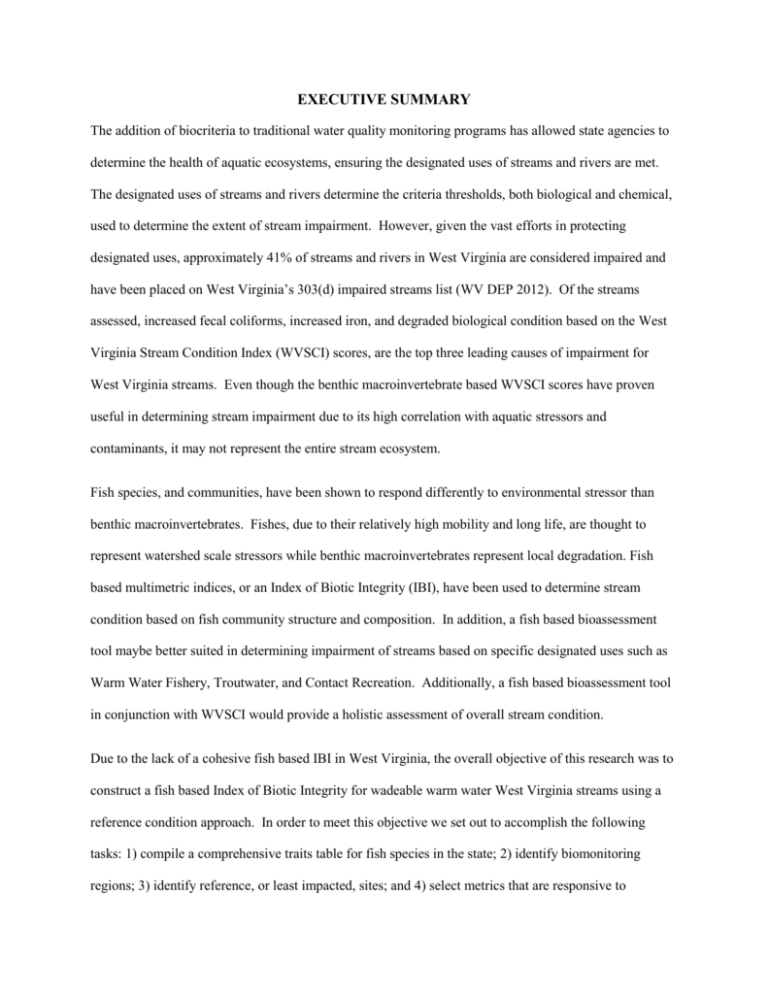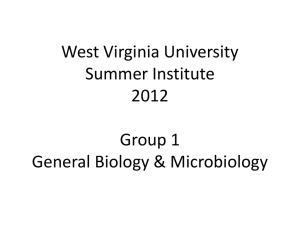executive summary
advertisement

EXECUTIVE SUMMARY The addition of biocriteria to traditional water quality monitoring programs has allowed state agencies to determine the health of aquatic ecosystems, ensuring the designated uses of streams and rivers are met. The designated uses of streams and rivers determine the criteria thresholds, both biological and chemical, used to determine the extent of stream impairment. However, given the vast efforts in protecting designated uses, approximately 41% of streams and rivers in West Virginia are considered impaired and have been placed on West Virginia’s 303(d) impaired streams list (WV DEP 2012). Of the streams assessed, increased fecal coliforms, increased iron, and degraded biological condition based on the West Virginia Stream Condition Index (WVSCI) scores, are the top three leading causes of impairment for West Virginia streams. Even though the benthic macroinvertebrate based WVSCI scores have proven useful in determining stream impairment due to its high correlation with aquatic stressors and contaminants, it may not represent the entire stream ecosystem. Fish species, and communities, have been shown to respond differently to environmental stressor than benthic macroinvertebrates. Fishes, due to their relatively high mobility and long life, are thought to represent watershed scale stressors while benthic macroinvertebrates represent local degradation. Fish based multimetric indices, or an Index of Biotic Integrity (IBI), have been used to determine stream condition based on fish community structure and composition. In addition, a fish based bioassessment tool maybe better suited in determining impairment of streams based on specific designated uses such as Warm Water Fishery, Troutwater, and Contact Recreation. Additionally, a fish based bioassessment tool in conjunction with WVSCI would provide a holistic assessment of overall stream condition. Due to the lack of a cohesive fish based IBI in West Virginia, the overall objective of this research was to construct a fish based Index of Biotic Integrity for wadeable warm water West Virginia streams using a reference condition approach. In order to meet this objective we set out to accomplish the following tasks: 1) compile a comprehensive traits table for fish species in the state; 2) identify biomonitoring regions; 3) identify reference, or least impacted, sites; and 4) select metrics that are responsive to anthropogenic stressors in order to construct and validate a fish based index of biotic integrity for wadeable West Virginia streams. Information gathered from a thorough literature review and from local experts was used to classify all fish species found within West Virginia based on their reproduction strategy, feeding behavior, tolerance, and native status, as well as other life history traits. This information was used to quantify, or summarize, fish community assemblage structure into richness and proportion metrics. Based on fish distributions and community metrics within previously identified reference sites, 4 biomonitoring regions were delineated in which an IBI was construction for warm water streams within each region. Final biomonitoring regions were determine by using distinct watershed boundaries and included: Monongahela Central Appalachians and Ridge-Valley (Mon CARV); Ohio Central Appalachians (Ohio CA); Ohio and Monongahela Western Allegheny Plateau (Ohio Mon WAP); and Upper Kanawha (UK). All fish community metrics were evaluated within each biomonitoring regions for their: 1) overall range; 2) correlation with drainage area; 3) discrimination between reference and stressed; 4) correlation with land-use; and 5) redundancy with other metrics. Final lists consisting of 7 – 9 metrics were retained within each region for the inclusion into a final IBI. The development of Indices of Biotic Integrity for West Virginia warm water, wadeable streams followed common standardized techniques for selection fish community metrics so that the final index in most of the biomonitoring regions were sensitive and responsive to anthropogenic impacts. Attempts were made to select metrics from key ecological categories (i.e. trophic, reproduction, and tolerance) in order to generate IBIs that give an overall view of stream condition. Final Index scores in each region were evaluated with anthropogenic land-use and water quality parameters in which most indices were responsive. The construction of fish based IBIs for West Virginia streams provides a starting point for evaluating the impacts of anthropogenic land-use patterns have on stream fish communities. Further research can now be done to compare the use of the benthic macroinvertebrate based index to a fish based index in the diverse geology of West Virginia. Finally, we hope that the fish based index will be used in conjunction with WVSCI to develop a holistic determination of aquatic condition for West Virginia streams and rivers for both preservation and remediation efforts.









